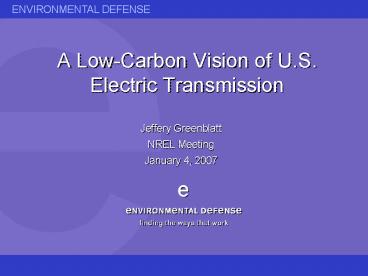A LowCarbon Vision of U.S. Electric Transmission - PowerPoint PPT Presentation
1 / 12
Title:
A LowCarbon Vision of U.S. Electric Transmission
Description:
2001: Vice President Cheney's task force identified transmission infrastructure ... Electricity demand is growing rapidly (1.4%/yr), and by 4%/yr in Southwest ... – PowerPoint PPT presentation
Number of Views:39
Avg rating:3.0/5.0
Title: A LowCarbon Vision of U.S. Electric Transmission
1
A Low-Carbon Vision of U.S. Electric Transmission
- Jeffery Greenblatt
- NREL Meeting
- January 4, 2007
2
Why a Vision Is Needed
- 2001 Vice President Cheneys task force
identified transmission infrastructure as the 2
goal (energy efficiency was 1), yet nothing has
been done in six years! - Electricity demand is growing rapidly (1.4/yr),
and by 4/yr in Southwest - gt More than 50 TWh/yr new capacity (7 GW
baseload) needed annually in U.S.
Sources NEPDG (National Energy Policy
Development Group), 2001. National Energy Policy
Reliable, Affordable, and Environmentally Sound
Energy for Americas Future, Washington, DC. ISBN
0-16-050814-2 EIA Annual Energy Outlook, 2006.
3
Enable a Low-Carbon Future
- U.S. electricity sector needs massive
decarbonization Emissions of 2600 MtCO2/yr in
2005, with enormous growth of coal projected - Key ingredients remote renewable electricity
(e.g. wind) and decarbonized coal from Heartland - Demand growth primarily on coasts (Pacific,
Southwest, Southeast) - Build it and they will come Enabling remote
low-carbon energy requires transmission
infrastructure in place
4
Electricity Demand Map
- Electricity demand 3900 TWh/yr in 2006
- Growth of 1.4/yr through 2030 (5500 TWh/yr)
- Estimate 7300 TWh/yr in 2050
- Greatest growth in SE, SW, Pacific
5
Wind and Coal Resource Map
Source Mike Dvorak, Stanford University
6
Goals
- Develop interstate highway proposal that will
result in one-time siting process, streamlining
future construction/upgrading - Sufficient capacity for near-term and long-term
demand 40 of U.S. generation by 2050 (3000
TWh/yr or 375 GW baseload) - Technology neutral, low-carbon mandate GHG
standard to prevent conventional coal without
CCS, encourage high renewable content (50?)
7
Anticipated Synergies
- Enable development of rural economy
- Stimulate development of CCS technology that can
be exported rapidly in rest of world - Encourage further renewable technology
development would not just benefit wind - Provide markets for coal/biomass polygeneration
plants to sell electricity - Use transmission rights-of-way for fuel pipeline
and coal railway networks
8
Role of Wind/CAES
- CAES can transform wind from a 30 to gt90
capacity factor resource - Large, remote wind will need storage to minimize
transmission costs and maximize winds
contribution - Trunk lines will primarily serve baseload markets
and will be easier to manage
9
Energy Policy Act of 2005
- Study to designate corridors on federal lands for
the transmission of electricity and fuel
pipelines stipulated in EPAct2005 - Report due August 2007
- Unclear of time horizon of study and priority
given to low-carbon/renewable energy - Opportunity to influence study (or at least use
as baseline for our study)
10
Proposed steps
- Generate alternative scenario(s) of U.S. energy
growth - Develop GIS maps indicating where needed
resources are (high-wind regions, coal seams,
underground CO2 geologies, compressed air storage
geologies, etc.) - Identify existing excess capacity on the grid, or
low-cost transmission upgrade opportunities that
could handle much of the increased flow of
electricity - gt Identify new, least-cost transmission
corridors to provide needed flexibility and
future capacity with minimum environmental impact - Produce a detailed report of above findings,
including discussion of possible financing
strategies and policy options
11
Proposed Team
- Jeffery Greenblatt, Environmental Defense
- Peter Black, GIS specialist, Environmental
Defense - Research assistant (to be hired) at Environmental
Defense - Bob Williams and Samir Succar, Princeton
University - Mike Dvorak, Ph.D. student, Stanford University
- Paul Denholm and Nate Blair, NREL
- Scott White, GIS specialist, Kansas Geologic
Survey - Partner at DOE?
12
Preliminary GIS Analysis































